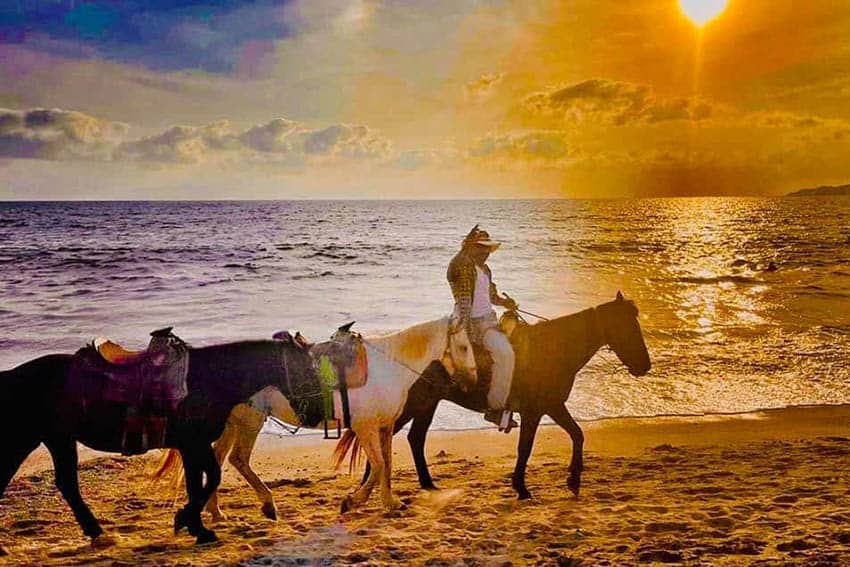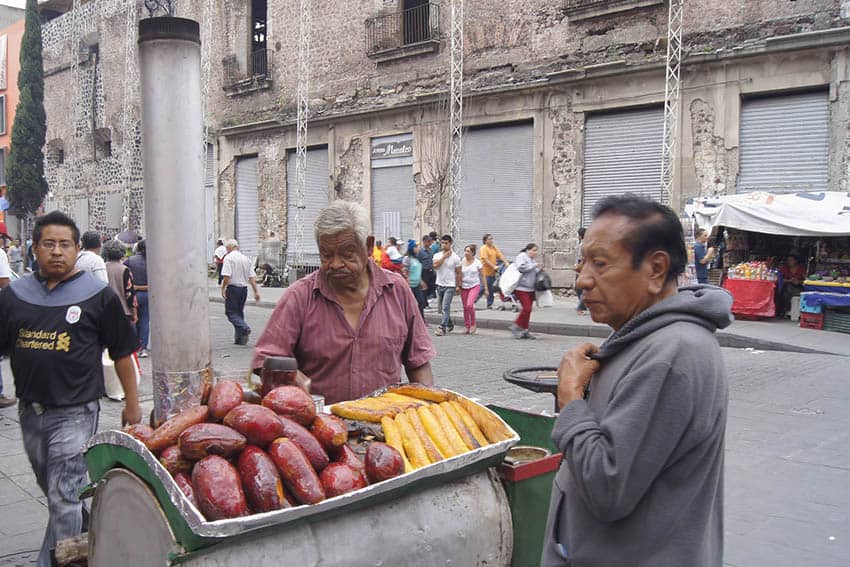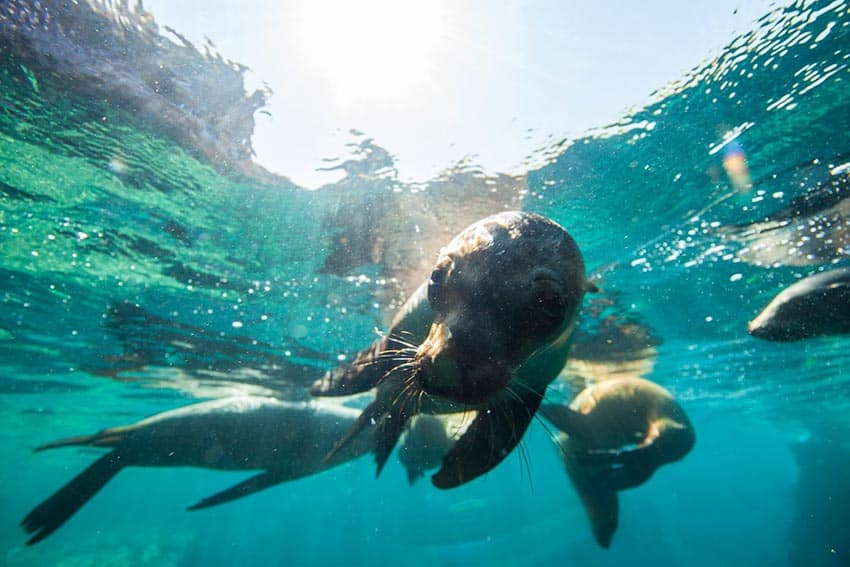
Bypass the Cabo Crowds for a smaller authentic Mexican Seaside Town
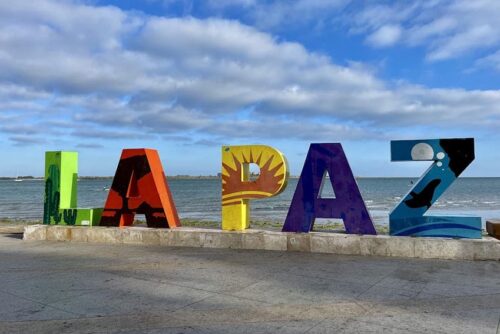
By Sharon Kurtz
Senior Writer
Instead of crowded nightclubs and glitzy resorts, I recommend driving up the coast a couple of hours to charming La Paz.
When you get there, head to the malecón. It’s the beating heart of the city.
La Paz is whimsical, colorful, and authentic—where majestic mountains merge with white sand beaches and crystal-clear turquoise waters.
The stunning coastal views, unspoiled ocean waters, and laid-back vibe make it a perfect spot for a getaway.
An eco-tourism haven, it’s a paradise for outdoor enthusiasts and water-sport lovers. Just two hours north of Cabo, find a slower pace and local culture in La Paz; it’s the real deal.

As the Gateway to the Sea of Cortez, there is a reason Jacques Cousteau described the area as “the world’s aquarium.” Nestled between two bodies of water, the warm waters of the Sea of Cortez and the Pacific Ocean, water activities abound, with more than 20,000 unique marine species in the surrounding waters.

La Paz History
La Paz was founded in 1548 by the Spanish conquistadors. The name was originally Nuestra Senora de La Paz, meaning Our Lady of Peace. In the mid-1800s, the city expanded with the growth of the pearl diving industry.
The architecture reflects that period of history and is part of what gives the old town its distinctive character today.
The Magic of the Malecon
The malecón is La Paz’s most famous landmark, an integral part of the city. It’s a colorful, lively mirror of the Mexican joie de vivre.
Stretching for three and a half miles along the waterfront, it connects the city with the sea.

The picturesque esplanade is lined with restaurants to the right, and beaches to the left, family-friendly and fun for all ages.
It is the city’s iconic highlight and pulses with vibrant energy.
Strolling the lively seaside promenade was one of my favorite activities. Walkers, bikers, and rollerbladers are out in force day and night.
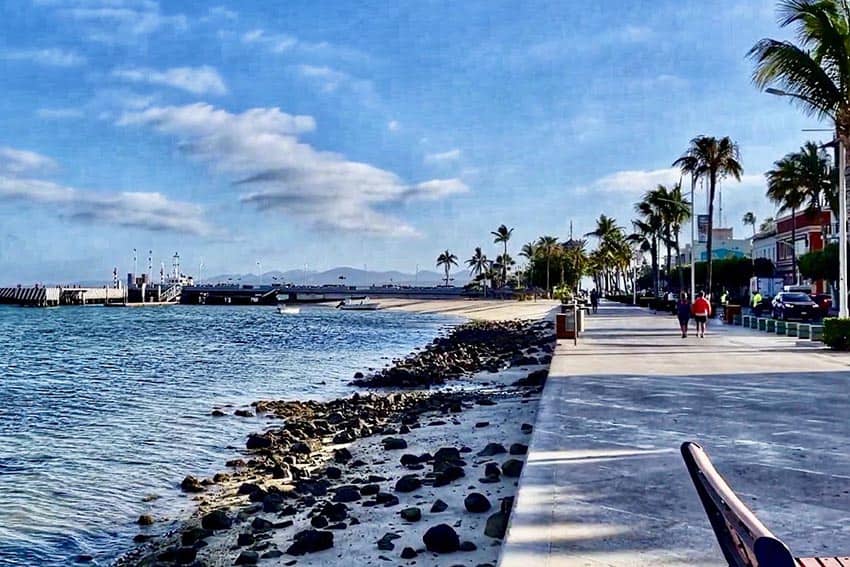
It includes tiny beaches, a fishing pier, skiffs and sailboats resting at anchor, stunning unimpeded sunset views, and fascinating sculptures by local artists.
Every 50 feet or so, small plazas curve into the bay and showcase a series of sculptures, a malecón must-see.
One of my favorites is Jacques Cousteau looking out at the whales and dolphins in La Paz Bay. Fitting because he’s the one who called the Sea of Cortez “the world’s aquarium.”
A giant clam sculpture speaks to La Paz’s history as a thriving pearl industry center in the 1930s— palm trees and nearby buildings reflecting on the gleaming pearl.
Some of the Malecon artworks take their inspiration from literature, including The Old Man and the Sea sculpture.
La Paz means “peace“ in Spanish and is aptly represented by the Dove of Peace sculpture, although some locals refer to it as “Paloma Gorda“‘, or fat pigeon.
The Urban Art of La Paz

La Paz shines brightly with over 80 hand-painted murals throughout the city created by artists from all over Mexico.
The artwork adds a pop of color to the already surrounding vibrant streets, the artists finding inspiration in local myths and legends.
The colorful murals and bold images display the cultural origins of the town, whimsical characters, and majestic marine life—using the sea as its anchor.
Espiritu Santo Island
Espiritu Santo Island in the Sea of Cortez is a natural treasure. It has been a UNESCO World Natural Heritage Site since 2005 and a National Park since 2007.
The scenic rocky Island is characterized by aquamarine tides and dry rolling hills and is home to many wildlife species, a jewel of biodiversity.
We explored the pristine coastal waters by boat, swimming with sea lions, spotting gigantic green sea turtles, and lazing about enjoying the natural beauty and turquoise waters.
The Sea of Cortez is one of the most diverse bodies of marine life, with tranquil and clean waters, unspoiled land, and pristine beaches – rightly earning its title as the world’s aquarium.
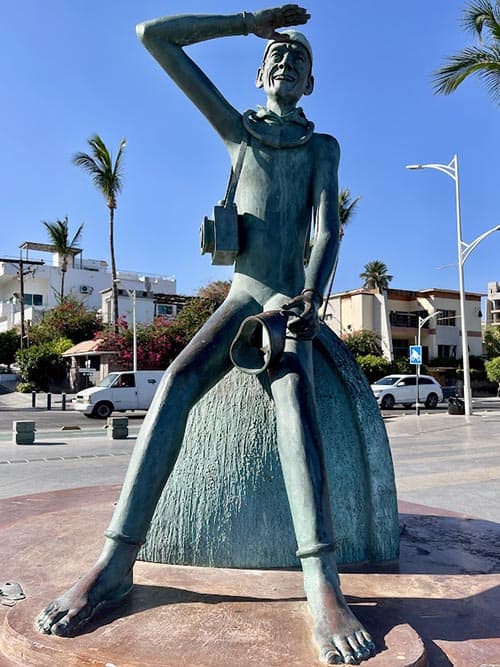
In it, you will find impressive scenic beauty, the contrast between sea and desert, volcanic rock formations, virgin beaches, and endemic plant and animal life.
Water sports in the Sea of Cortez
La Paz is a perfect combination for the water lovers that visit Baja Sur.
Whether you prefer snorkeling, kayaking, or stand-up paddle boarding in the lush Balandea Bay Mangroves, there are plenty of activities to choose from.
Only 40 minutes from La Paz is La Ventana, a place on the Sea of Cortez where a natural air tunnel is created, which lends itself to Kitesurfing and Windsurfing.
La Paz boasts many beaches on the mainland and on its surrounding Islands.
Balandra Beach is a favorite at the point of the peninsula. This is where you will find Mushroom Rock, which has long been the symbol of La Paz.
Swim with the Sea Lions, Dive with Whale Sharks
The largest sea lion colony in the Sea of Cortez is Los Islotes. These creatures are highly social and live happily in very close company.
Sea lions have a balletic grace, where they can dive as deep as 900 feet and remain submerged for over half an hour.
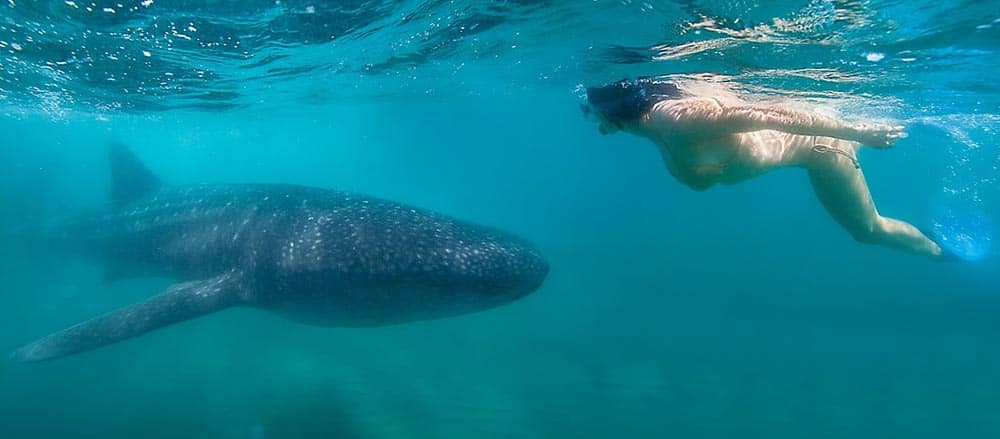
We swam and snorkeled close to the rocky outcrop while the comical pups playfully interacted with us. The large bulls postured and showed off for the females, barking and posing on rocky points, some reaching upwards of 1,500 pounds.
Regulations limit the number of visitors to Los Islotes to protect the site’s ecosystem – making it a one-of-a-kind encounter.
Also in the neighborhood are the whale sharks, the largest known fish growing up to 42 feet long. Don’t worry; they don’t bite. Swimmers can glide alongside these slow-moving, docile plankton eaters. They are present around La Paz from October to April.
Whale Watching in the Bay of La Paz

The Baja Peninsula is a premier spot for whale watching. From January through March, the Pacific Ocean and Sea of Cortez are abundant with migrating whales. They travel 20,000 miles from the Bering Sea to reach the warm waters of La Paz, where they give birth and mate.
The Bay of La Paz is a protected area, sheltered from the open Gulf of California, making it easy to spot the majestic creatures.
Grey whales are the most commonly observed, but others traveling to the area include blue, humpback, and pilot whales.
Several local guides offer tours where you can get close to the majestic creatures.
Feast on the Chocolate Clams
Nicknamed “Baja’s seafood candy,” chocolate clams are a specialty of the Baja Peninsula. It’s a dish many visitors seek out, a famous culinary emblem of the region.
Their common name results from the brown shell, not because of their flavor. They have meaty, tender flesh that makes them exceptionally delicious.
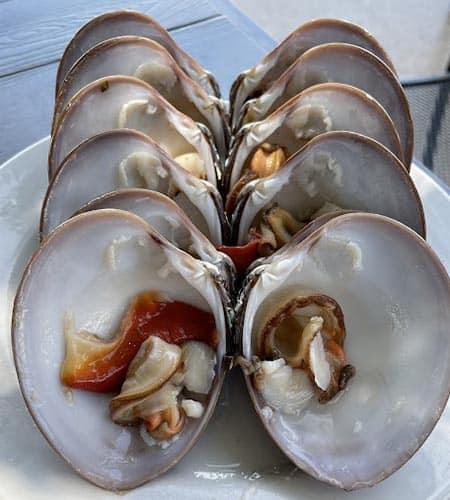
The most giant west coast bivalve clams can grow to six inches in diameter. Often served raw with a squeeze of lemon, my favorite, was cooked on the half shell on the barbecue, then slathered with a garlic butter dressing.
I tried my first chocolate clams as soon as I arrived in La Paz at one of its popular restaurants, Bismarkcito, a well-known spot for seafood right on the Malecon. It was a fresh seafood feast—the outdoor seaside seating lending to the ambiance.
Other places to enjoy clams and different types of seafood are area eateries and streetside carts—with fish so fresh they have been known to jump from the water to your plate.
Baja Club Hotel on the Malecón is the perfect home base.
The newly opened Baja Club Hotel occupies a colonial-era former private mansion. The small luxury boutique hotel is located on the Malecon in the historic center of La Paz, with a phenomenal view of the Sea of Cortez right across the street.
The restored villa has retained much of its charm. It formerly belonged to an affluent family of the once-thriving pearl farming culture. The center of the property is a cobbled courtyard and fabulous restaurant that leads to the new four-story annex.
The beautiful pool and modernist free-form sculptural staircase are Instagrammable spots. The original preserved outer walls provide a backdrop that seems ready for a glossy magazine photo shoot and serves as a boundary on the property.
Watching the sunset from its rooftop terrace was my favorite happy hour activity.
I stayed in Room A on the ground floor in the original colonial-style villa. With its soaring wood ceiling, terrazzo floors, and hacienda details, I felt I could have been “La Señora de la Casa” in an earlier era.
Sandboarding on the Dunes

Our nighttime stand-up paddle boarding plan in the Balanda Bay mangroves was canceled because of high winds.
That was disappointing, but sometimes a change of plans leads to something just as good—sand surfing!
Surfing the Dunes in La Paz
La Paz’s ecosystem provides coastal dunes very close to the city. Just drive 30 minutes, and you can have a blast surfing in these soft, changing mountains of sand.
They said it wasn’t necessary to have experience, so this newbie made it to the top, strapped the board to my feet, and was ready for a few quick instructions.
Soon, I was shredding it like a pro, carving the dune and feeling the adrenaline of speed in the sand. It was epic!
Well… I might be exaggerating just a tad. It took me more than a few tries to make it down the dune upright, falling more times than I care to share—that walk back up to the top was a killer.
I did have a final run where I managed to stay on my feet all the way to the bottom, whooping it up in celebration, arms raised in victory.
You would have thought I won an Olympic medal. It’s memories like these that make travel worthwhile.
Visit colorful nearby towns of Todos Santos and El Triunfo
Colonized in 1723 by Jesuit missionaries, today, Todos Santos is a haven for artisans, surfers, and travelers seeking adventure and a healthy lifestyle.

In recognition of its geographical beauty and historical importance, it has the special designation of being a “Pueblo Magico” – a magical town.
This easy day trip where the desert meets the Pacific offers charming cobblestone streets and art galleries. Decorated with colorful facades and papel picado strung above the thoroughfare—it’s a scene worth the drive.
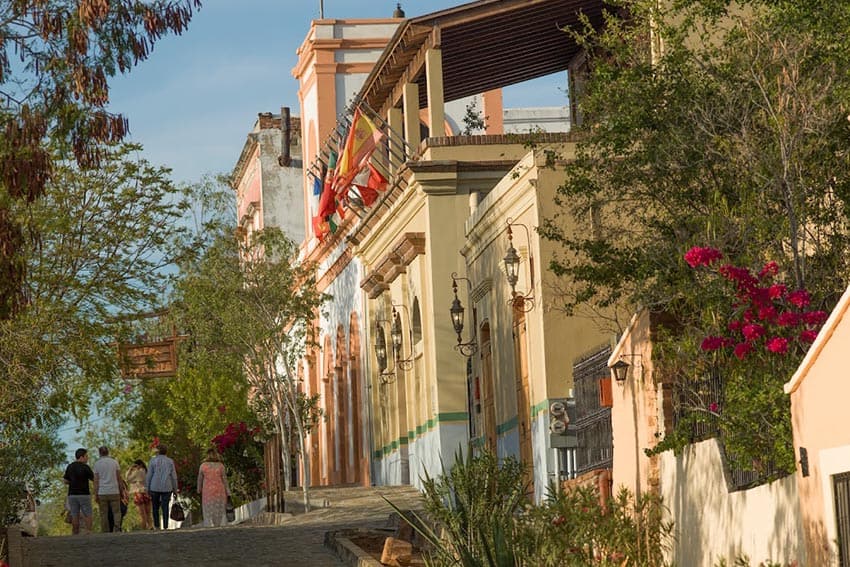
El Triunfo was once a thriving old silver mining town in Baja California Sur. Its first mine started in 1748. Home to just a few hundred residents, it’s now considered an “in situ” museum, filled with well-preserved buildings and mansions from the era.
This laid-back, authentic coastal town is worth a visit.
There are many reasons travelers should escape to La Paz. The seaside enclave is less explored and, unsurprisingly, less expensive. You will be happy you bypassed touristy Cabo San Lucas for a more authentic experience. From Balandra Beach to the malecón, there’s something for everyone.
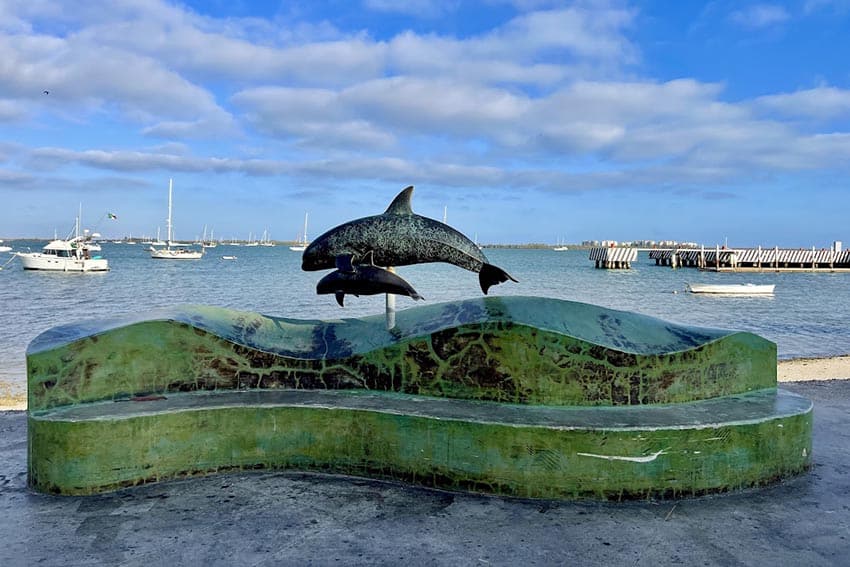
La Paz Details
La Paz is a great destination any time of the year. It is rainiest in August and September and sunny and dry from March to June. It is an easy flight from many US Cities to SJO (Cabo San Lucas), then a short drive north to La Paz. There also is a direct flight from Phoenix to La Paz.
Learn more about La Paz or make a reservation: https://golapaz.com/en/
- Jasper, Alberta: Winter Perfection - April 3, 2024
- Whooping it Up in Port Aransas, Texas Gulf Coast - March 21, 2024
- South Dakota Surprises - January 19, 2024


